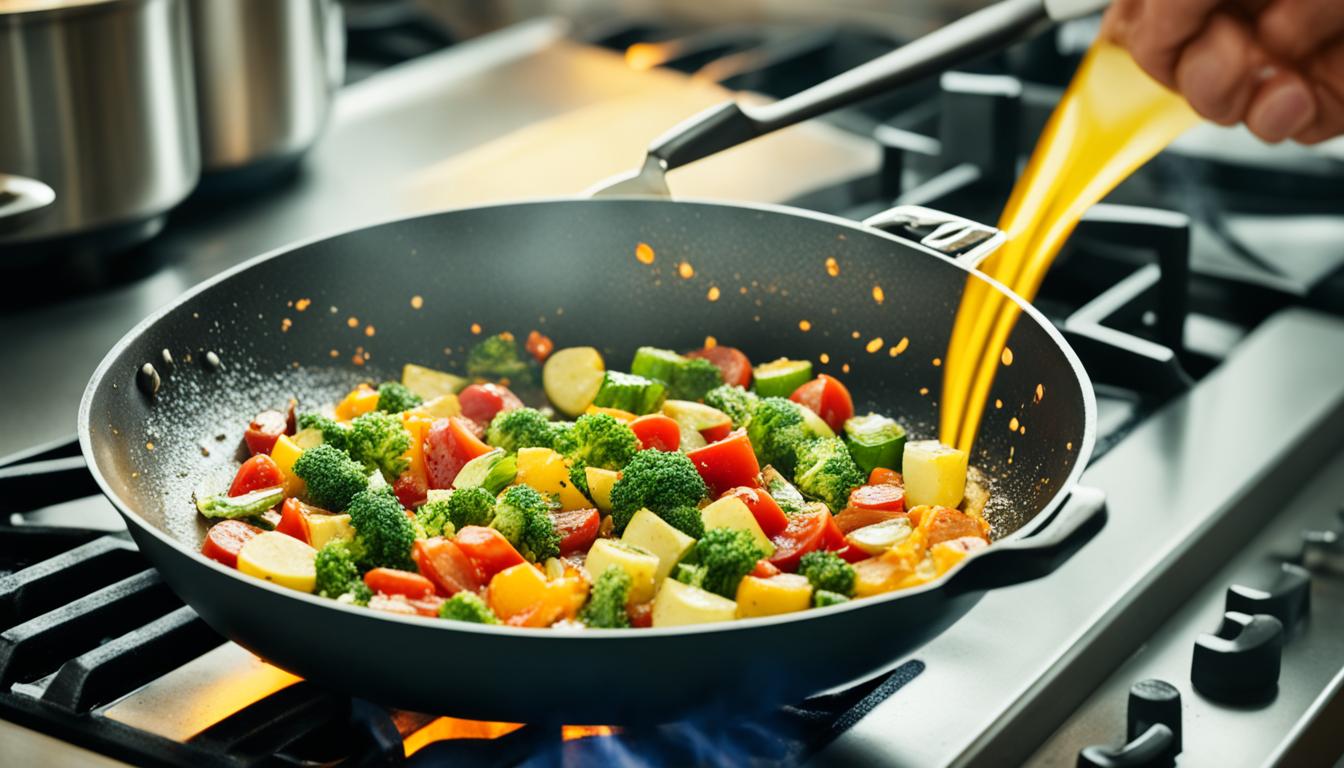Have you ever wondered why your sauteed dishes sometimes turn out unevenly cooked or stick to the pan? It could be because you’re not adding enough oil when sauteing. But wait, isn’t less oil healthier? So, how can adding more oil actually benefit your sauteing technique?
When it comes to sauteing, adding sufficient oil is crucial for achieving proper browning and even cooking. Neglecting to add more oil when the pan seems dry can result in patchy browning and sticking. Regardless of the amount of oil called for in the recipe, it is recommended to always add more oil to the pan when sauteing if it appears dry. A consistent sheen of oil on the bottom of the pan promotes even cooking and prevents sticking.
So, how does adding oil contribute to better sauteing? The points of direct contact between the food and the pan heat up faster through conduction, while the parts of the food in contact with the hot oil are heated via convection. If the pan starts to run dry, too much of the food ends up cooking via conduction, which can lead to burnt bits or uneven browning. Furthermore, oil helps prevent sticking by forming bonds with the metal atoms on the pan’s surface and creating a buffer zone between the food and the pan.
Want to discover more sauteing techniques and tips for perfect results? Keep reading!
Sauteing Methods and Techniques
Sauteing is a versatile cooking method that involves cooking food in a small amount of fat in a frying pan. Whether you’re a beginner or looking to perfect your sauteing skills, understanding the various sauteing methods and techniques is key. Let’s dive into the step-by-step process of sauteing and explore some useful tips to help you achieve delicious results.
Choosing the Right Pan
When sauteing, it’s important to choose the right pan. A large fry pan with rounded edges is ideal for flipping the food effortlessly. Stainless steel and nonstick pans are recommended options. Stainless steel pans are non-reactive and easy to clean, while nonstick pans are best for foods that tend to stick. Remember to use non-metal utensils with nonstick pans to avoid damaging the surface.
Selecting the Perfect Oil
The choice of oil plays a crucial role in sauteing. Consider the recipe and desired cooking temperature when selecting the oil. Oils with high smoke points, such as canola oil, sunflower oil, or peanut oil, are ideal for high-temperature sautes. They can withstand the heat without breaking down and imparting an unpleasant flavor.
The Sauteing Process
Now that we have the pan and oil sorted, let’s go through the step-by-step process of sauteing:
- 1. Preheat the pan: Heat the pan over medium-high heat before adding the oil. This ensures even cooking and prevents sticking.
- 2. Add the oil: Once the pan is hot, add enough oil to lightly coat the bottom. This helps prevent food from sticking and promotes proper browning.
- 3. Distribute the food: Spread the food evenly in a single layer in the pan. Avoid overcrowding the pan to ensure even cooking.
- 4. Flip with a flick: To ensure even distribution of heat, use a flicking motion to flip the food in the pan. This helps achieve uniform browning and doneness.
- 5. Pay attention to cooking time: The cooking time for sauteing varies depending on the ingredients. It is generally a quick cooking method that requires careful attention to prevent overcooking or undercooking.
Exploring Sauteing Possibilities
Sauteing isn’t limited to specific ingredients. It can be used with a wide range of meats, vegetables, and even flavor-enhancers like garlic or onions. Each ingredient may require specific cook times and techniques. Experimenting with different combinations and flavors will enhance your sauteing skills and expand your culinary repertoire.
By following these sauteing methods and techniques, you’ll be well on your way to creating delicious, perfectly sauteed dishes. Don’t be afraid to get creative in the kitchen and discover the joy of sauteing!
Sauteing Tips for Perfect Results
To achieve perfect results when sauteing, it is important to follow a few additional tips. The choice of oil plays a crucial role in enhancing the flavor and texture of the dish. For the best sauteing experience, consider using clarified butter, which has a high smoke point and ensures even browning. Alternatively, you can use olive oil, canola oil, or a combination of fats to achieve the desired flavor profile.
Preheating the pan before adding oil is another crucial step to ensure even cooking and prevent sticking. Make sure to heat the pan until a drop of water sizzles and evaporates quickly. Adding just enough oil to lightly coat the bottom of the pan will prevent food from sticking and ensure proper browning.
When sauteing, it is important not to overcrowd the pan. This allows the food to cook evenly and facilitates flipping without any hassle. Keep an eye on the food and flip it at the right time to achieve the desired level of browning and doneness. Sauteed vegetables should be cooked until they are slightly crunchy and retain their texture, while onions or garlic can be sauteed until browned for added flavor.
Sauteing offers a quick and healthy cooking option with its minimal oil requirement, making it ideal for everyday meals. By following these sauteing tips and tricks, home cooks can improve their skills and create delicious dishes with ease. So, next time you saute, remember to choose the best oil for sauteing and apply these techniques for perfect results.
